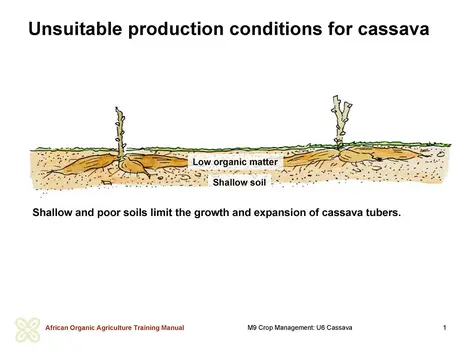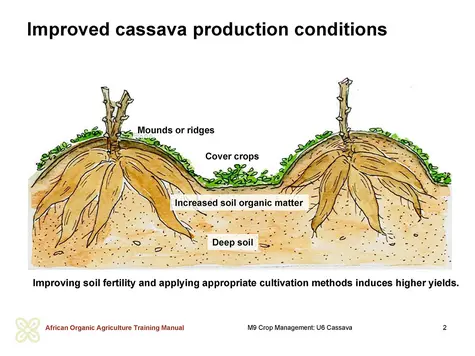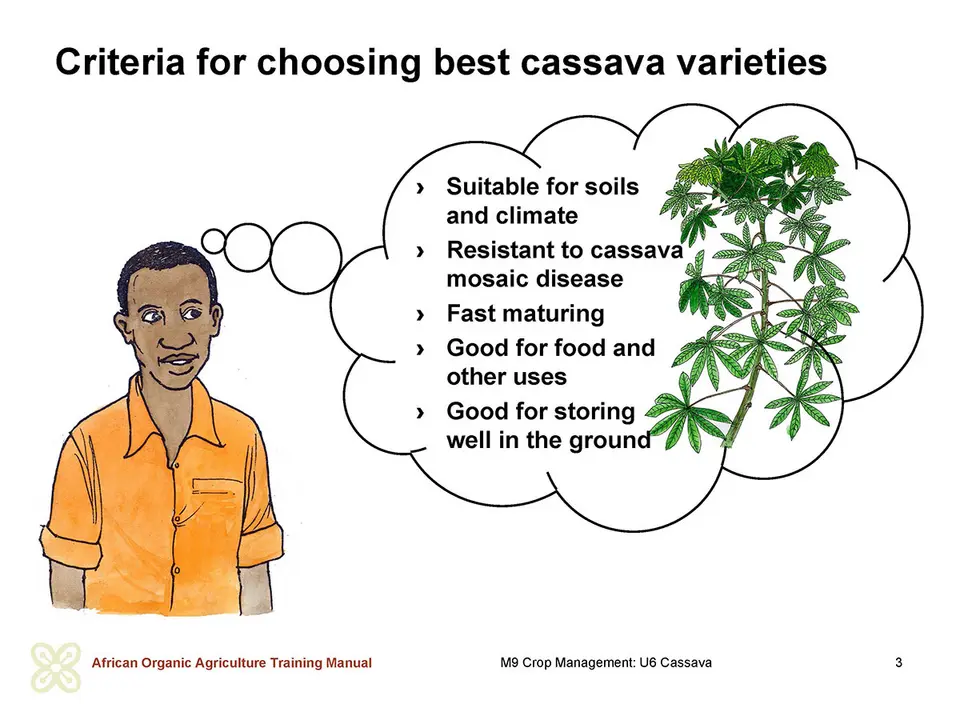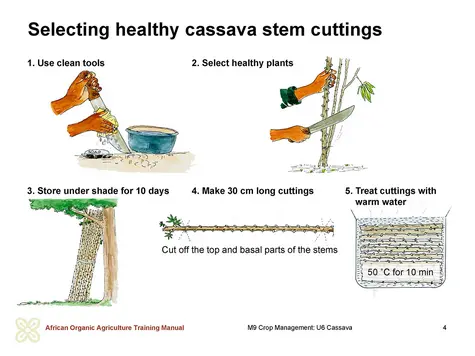Introduction
Next to yam, cassava (Manihot esculenta) is a commonly produced tuber crop in Africa. It can be used as food and as a cash crop, feed for animals and as a source of industrial raw material. In sub-Saharan Africa, cassava is mostly used for human consumption in various forms ranging from boiling the fresh tuber to processing it into cassava flour. Cassava tubers are an important source of carbohydrates while the leaves, eaten as a vegetable, are a good source of protein and vitamins. Cassava is grown mostly by small-holder farmers as an important food and as a cash crop. According to FAO’s estimates, the average fresh tuber yield of cassava under traditional farming practices in sub-Saharan Africa ranges between 5 and 8 tons per hectare. This is much lower than its potential yield capacity of 40 to 60 tons per hectare.
Challenges facing cassava production in Africa
- Low productivity - Although cassava is an important crop with multiple uses, it does not receive the much needed attention during its production. Farmers normally plant it on very poor soils, where sometimes other crops like maize have failed. Sometimes cassava is grown as an insurance intercrop with other nutrient-demanding crops like maize or sorghum, just in case the main crop fails. Cassava is predominantly a crop for small-holder farmers, who basically grow for subsistence, using rudimentary tools and operating on small and fragmented plots. Infections by the cassava leaf mosaic disease, the cassava brown streak disease and the cassava mealy bugs and scales further reduce crop yields.
- High postharvest losses - Poor postharvest handling leads to uneven quality of the processed cassava and results in contamination by fungi. Poor and inadequate infrastructural facilities for milling and storage, and poor access to roads, which are vital for adding value, further increase the postharvest handling challenges.
However, cassava remains a desirable crop because of its many advantages. It is easy to produce, adaptable to many environments, has minimal labour requirements and is comparatively less susceptible to pests and diseases than most other crops. This implies that there is need to address the above challenges in order to increase productivity, marketing opportunities and profitability of cassava production. The following organic practices can contribute to achieving these goals.
Assessment of the local cassava production situation
Inquire among the participants about cassava production in the area by asking the following questions:
- What is the general perception about cassava as a food crop? Is it considered an important crop?
- Under what conditions is it normally cultivated?
- What are the advantages of growing cassava as a crop compared to other crops?
- How is cassava used in the area?
Use transparencies 1 and 2 to discuss the status of cassava to the farmers.
Proper establishment of the cassava garden
Selection of suitable varieties
Cassava varieties differ with regard to yield potential, flesh colour (white or yellow-fleshed), diameter and length of the tubers, disease and pest resistance levels, time from planting to harvest, cooking quality and taste. Some cultivars require 18 months or more from planting to harvest while others are ready to harvest in 9 months. Most cultivars have been selected by farmers under their growing conditions based on yields and cultural tendencies. Each growing region has its own special cultivars with farmers, often growing several different cultivars in the field at the same time.
Recommendations to farmers for selecting suitable cultivars:
The best cassava varieties are those that are preferred by consumers and—important to the farmer—grow fast, give good yields, store well in the soil and are tolerant to the major pests and diseases. The following criteria could be useful for selecting cassava varieties for organic production:
- Good adaptation to local conditions - To figure out which variety can do well in your area, it is important to be aware of the general growing conditions for cassava including length of the rainy season, prevalent diseases, pests and weeds. Such information helps to determine, what characteristics a variety needs to perform well.
- Varieties with high dry matter and good food quality - Cassava varieties with tubers with a dry matter content of more than 30 percent are said to produce good quality products and are, therefore, more profitable for processing.
- Adaptability to different uses - The selected cassava variety should be adapted to multiple uses such as food, animal feed or industrial processing. Varieties that are commonly preferred are with tubers that are tasty for home consumption, can store well for processing purposes and produce enough foliage for animals.
- Ability to bulk early - Varieties that show early bulking, meaning the swelling of the root tubers, are better able to compete with weeds, for example, than late maturing varieties, and are suitable for drier areas with short rains.
- Ability to store well in the ground - Varieties that keep the tubers in good condition for a long time after reaching maturity are preferred by some farmers. Good ground storability leaves more time for harvesting, thus reducing the duration of postharvest storage problems of fresh roots.
- Resistance to local weeds, pests and diseases - Varieties that can tolerate the prevalent diseases and pests in the area are most preferable.
Knowledge sharing on selection of suitable cassava cultivars
Note down the common cultivars grown in the region and involve the participants in the discussion about the differences between these cultivars in their suitability to local conditions, their tuber form, size and use, their adaptability to processing and market requirements, their resistance to local pests, diseases and weeds, and yields, and their availability.
Selection of an appropriate planting site
Cassava is drought tolerant and can be grown on most soils, and will give some yields even on poor soils where most other crops fail. However, high yields are obtained in areas with well-drained loamy soils, well-distributed annual rainfall of 1,000 to 1,500 mm, and warm and moist climatic conditions only. The best site for planting cassava is flat or gently sloping land. Steep slopes are susceptible to erosion and are, therefore, not very suitable areas for growing cassava. Valleys and depression areas are also not recommended because they are prone to water logging. Cassava is sensitive to water logging and heavy soils do not allow the crop’s roots to proliferate and develop well
Proper land and seedbed preparation
In cassava cultivation, it is important to till the land in order to loosen up the soil, improve soil drainage and make it easy for roots to develop. The level of tillage required for the cassava field mainly depends on the soil type and the drainage at the site selected for cassava cultivation. In places with shallow soils or poorly drained clayey soils, it is important to make mounds or ridges onto which the cassava is planted to encourage better root development and yields. In sandy soils, minimum tillage and planting of cassava flat into the soil are more appropriate, as the soil is sufficiently loose to allow root development.
Preparing good quality planting material
Cassava is mainly propagated by planting pieces of the stem (stem cuttings). This means that the development of cassava and amount of yields will depend on the quality of stem cuttings. There are several cassava pests and diseases, which are stem-borne. Therefore, selection of healthy stem cuttings will greatly reduce the spread and damage caused by these pests and diseases.
Recommendations to farmers for selecting good cassava stem cuttings:
- Select planting material from healthy growing, high-yielding, 8 and 18 month old cassava plants. Healthy cassava plants have robust stems and branches, lush foliage, and minimal stem and leaf damage caused by pests and diseases.
- From each plant select the middle, brown-skinned portion of stems as stem cuttings. The stems should be 2 to 4 cm thick. These parts sprout and ensure plant vigour better than the top green stem portions. Stem cuttings taken from the top green portions or extreme top and bottom portions of stems are unsuitable. They will dehydrate quickly, produce unhealthy sprouts, and are easily damaged by pests and diseases.
- Tie the selected stems in bundles and wait for at least 10 days before planting them. The harvested stems can be stored for over 2 months in dry, well-ventilated, shaded areas away from direct sunlight until it is time for planting. One simple method of storing stems consists of arranging them vertically under a shady tree, with the oldest part of the stem buried in the soil. The soil should be moist to keep the stems ‘alive’ as leaves will form on the upper part of the stems. After storage, discard the top and basal parts of the stems, and use the middle part as cuttings. Another method, mainly used under cold conditions, consists of storing the stems in underground tunnels, which are protected from water. The stems are placed inside the tunnel on top of a layer of dry straw, and then covered with another layer of straw and soil.
Discussion on preparation of planting materials
Let the farmers explain how they prepare their cassava cuttings according to their local conditions. How do they store cassava cuttings for later planting? Identify any shortcomings of the methods used and introduce the recommendations below.
Proper planting of cassava stem cuttings
In order to get the best sprouting and growth from cassava stem cuttings, it is important to plant them properly. For this reason, the following considerations are recommended:
Selection of suitable planting dates - Planting cassava early, at the beginning of the rainy season, ensures healthy sprouting and good plant establishment. This enables the plant to withstand attack by diseases and pests later in the season.
Proper preparation and handling of stem cuttings - When cutting up cassava stems into pieces for planting, each cutting should be between 20 and 30 cm long and have about 5 to 8 nodes, where the roots and shoots originate. The interval between cutting of the stems and planting into the ground should be as short as possible to avoid dehydration and poor performance. Soaking the stem cuttings before planting in warm water (50o C) by mixing equal volumes of boiling and cold water for 5 to 10 minutes just before planting prevents stem-borne pest attacks.
Adopt suitable planting mode according to the type of the soil - Cassava cuttings can be planted by hand vertically, at an angle (inclined) or horizontally, depending on soil types. The drier the soil, the bigger the part of stem placed in the soil. The vertical planting method is best suitable in sandy soils and consists of planting the cuttings vertically with two-thirds of the length of the cutting below the soil. Planting at an angle is most suitable in loamy soils and consists of planting the stem cuttings vertically and with an angle ranging from slightly above horizontal to about 45°. Horizontal planting is recommended for dry climates and consists of placing the entire stem cutting horizontally in the soil at a depth of about 5 to 10 cm.
The spacing between the cassava plants depends on several factors such as the variety used, the soil type, soil fertility and water availability and on whether cassava is grown alone (monocrop) or with other crops (intercrop). For example, if cassava is being grown alone, a distance of 1 metre between the plants should be considered. If cassava is being grown as an intercrop, the distance between the crops should range from 1 to 4 meters depending on the branching habit of both the cassava and the other crops to make sure there is enough space for the plants.
Discussion on proper planting of cassava
Inquire among the farmers about how cassava is planted locally. At what time of the year is it planted and why? How is it planted?
Intercropping
Due to the fact that cassava has a slow initial development, intercropping during early crop development is feasible, and helps reduce soil erosion. However, farmers should consider that cassava is a poor competitor and can easily be shaded out by tall intercrops like maize. For this reason, it is important to consider the branching habit of both the cassava and the other crops in the intercropping system and make sure there is enough space for both crops. Furthermore, cassava can suffer from nutrient and/or water competition from intercrops. Therefore, attention must be given to the intercropping species that have different root systems and nutrient requirements.
Farmers usually intercrop cassava in simple or complex mixed cropping systems with vegetables such as amaranth and okra, plantation crops such as coconut and coffee, maize and legumes such as cowpea and groundnuts. The intercropping pattern depends on the environmental conditions, food preferences and market conditions of the region.
Simple mixtures consist of the intercropping of only two crops, in which farmers select arable crops on the basis of differences in growth habit and time of maturity. For example, cassava, which is a long-duration crop with 9 to 18 months to maturity, is often intercropped with short-duration crops with 2 to 5 months to maturity such as maize, cowpeas, groundnut, okra and melon. These crops mature when the cassava is just attaining its maximum leaf area development and thus is able to expand its root tubers without competition. In complex mixtures consisting of three or four crops, good yields have been obtained with the following combinations:
- maize / cassava / melon
- maize / groundnuts / cassava
- maize / cassava / okra / cowpea
- maize / yam / cassava
- maize / beans / cassava
Complex mixtures improve weed suppression, reduce soil temperature, retain higher soil moisture in the topsoil, and produce more organic matter than single cropping or simple mixtures. Nutrient loss from erosion in complex mixtures is less than in single cropping.
Group work and discussion on intercropping patterns
Ask the farmers to form groups and to design an intercropping system according to the specificities of the region. Each group should present the results for discussion in the plenum.




 tap and then scroll down to the Add to Home Screen command.
tap and then scroll down to the Add to Home Screen command.